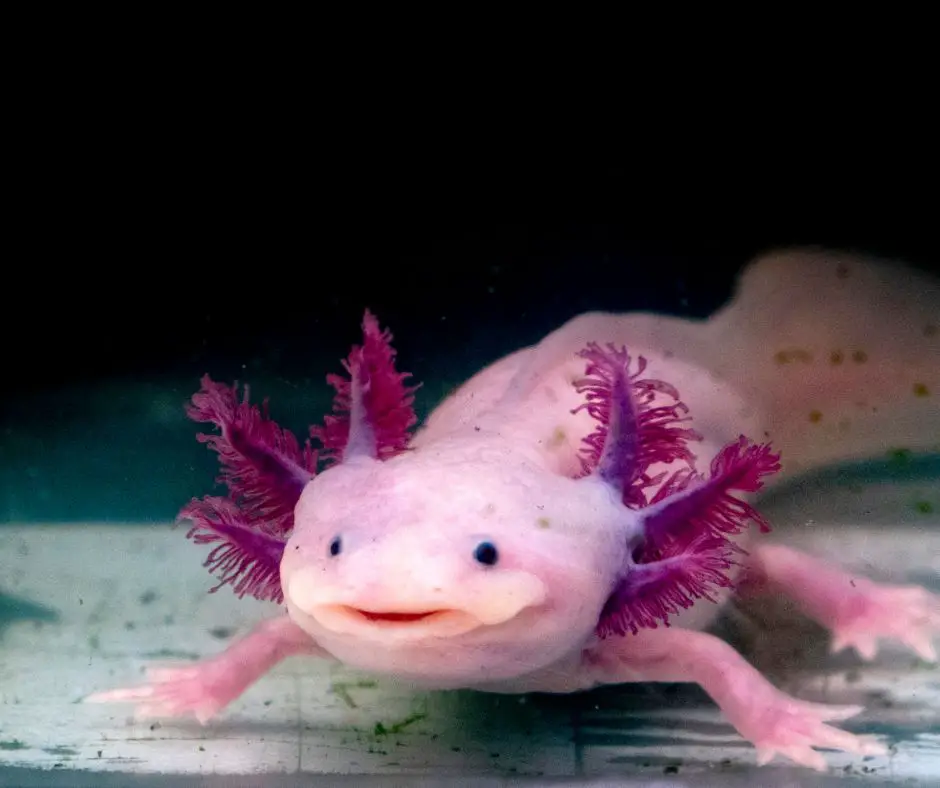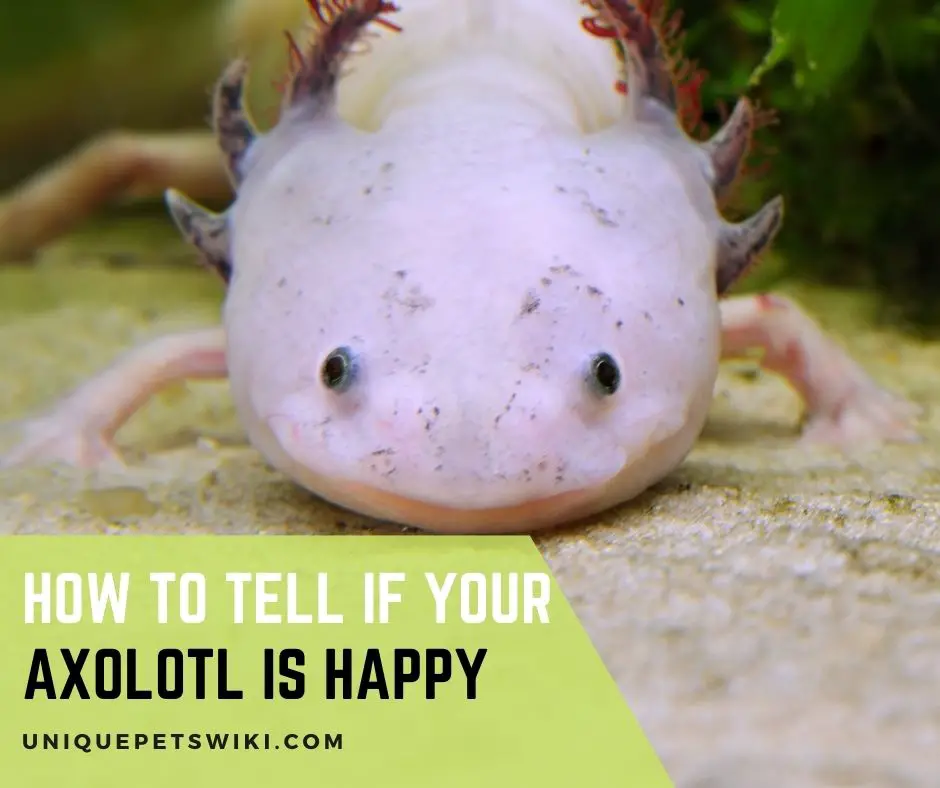Axolotls have a natural smile on their faces, but does that mean they are happy? Axies do not laugh, and they certainly have no way of expressing their feelings to their owners.
So how can you tell if your Axolotl is happy? Most importantly, every responsible Axie parent should be asking this question because mental health can affect your pet’s overall well-being.
Thankfully, some signs indicate whether your pet is happy. And that is exactly what this guide is all about.
Contents
How to Tell If Your Axolotl Is Happy?
Your axolotl will be happy if you take good care of it. It will be happy if you feed it a nutritious diet and maintain an optimum environment.
Different Axies will show ‘good health’ and happiness in different ways. It depends on their age as well.
Some young ones may have ‘fun’ climbing on plants or hiding in the hideouts you have provided or they may swim around all the time.
If you have a bubbler, a happy Axie might play with its bubbles. Older Axies might relax and do nothing.
Here are some other signs when your axolotl is happy: relaxed gills, good appetite, energy, and optimum movement, and no signs of stress.
Happy Axies will also move around the tank effortlessly. The young ones will swim a lot, while the older Axies will at least show some movement when they feed.
Their skin will also have a healthy pallor. Axies come in almost 16 different colors, but whatever the color may be, their skin will look healthy.
Lastly, a healthy Axolotl is also happy; it will have energy and be active.
Remember that although your Axolotl has a ‘smile’ on its face – it isn’t always an indication that it is happy.

Happy Axolotl’s Gills Flow Freely and Effortlessly with No Tension
Axolotl’s gills are not just breathing appendages. They are also one of the ways they show their feelings. A happy Axie will have relaxed gills; there won’t be any tension in them. They will float or flow freely.
Conversely, curved or curled gills indicate that your pet isn’t happy with the water parameters.
- Curled gills are one of the main signs that an Axie is unhappy or stressed. If the gills are curved towards your pet’s face, then one of the reasons may be that the water parameters aren’t optimum, which may be a source of stress for your pet.
- Axolotls that are unhappy and unhealthy often lose their gills. Poor water quality is one of the main culprits and can cause gill loss and breakage.
- If an Axolotl has white spots on its gills and is continuously scratching them, then it could be an indication of fungal infection. That certainly won’t make any Axie happy.
Please note that gills are not a surefire indication of an Axolotl’s happiness. Some young Axies have longer gills that tend to curl towards their faces. As your pet grows, the gills straighten out too. So, age is an important consideration.
Good Appetite
Most juvenile Axies need daily feeding. Adult Axies can be fed once every couple of days and some even go without food for several days.
However, if your Axie is not eating for weeks on end, then it is an indication of ill-health, stress, and unhappiness.
The most important indicator of good health and happiness is that your pet will be eating well. It will look forward to its meals – whether you feed it worms, larvae, tadpoles, or special axolotl pellets.
Energy and Optimum Movement
Young or juvenile Axolotls are usually more energetic and tend to swim around a lot. Some even swim up towards the walls of the tank to ‘greet’ you. They tend to recognize their humans and like to show them their appreciation for feeding them and taking care of them.
As they grow older, their movement and energy levels will drop a bit. However, a happy adult Axie will at least swim out to eat its food. The rest of the time, it may simply remain inactive which is usually normal in most cases as long as it eats.
No Signs of Stress
A happy axolotl will have no signs of stress. Signs of stress in Axies are:
- Curved or forward curled gills are the main sign of stress in axolotls.
- Lack of appetite and refusing food for days is another sign.
Read article axolotl stress signs to know more about axolotl
What Makes an Axolotl Happy?
Optimum tank conditions can make your Axolotl happy. These include:
- Proper Housing
- Lighting
- Proper Oxygen Pump/Filter
Proper Housing
A 10-gallon tank is usually sufficient for one Axie. However, it is best to buy a 20-gallon tank as that will give your pet adequate space to move and swim.
Pay attention to the substrate too. Use axolotl-safe substrate such as terrarium sand. Avoid gravel which these pets have the bad habit of ingesting.
Aqueon Aquarium 20 Gallon Long
- High quality glass construction with dimensions 30.25" x 12.5" x 12.75"
- For freshwater and marine applications
- Clean silicone edges (select sizes available in clear or black)
- Always include a drip loop when plugging aquarium appliances into the electrical outlet
- Place aquarium on stand able to safely bear the weight of a filled aquarium
Last update on 2022-12-29 / Affiliate links / Images from Amazon Product Advertising API
Lighting
Axolotls do not have eyelids and bright lighting can stress them out. Natural lighting is the best for Axies. Try to avoid any artificial or bright lights. If you have plants in the tank, only add ones that need very little light.
Low or dim LED lighting is suitable for axolotls and it may make them happy. This product is ideal as it mimics sunlight’s natural effect underwater.
BeamsWork DA FSPEC LED Aquarium Light Pent Freshwater
- Lumen: 2800
- LEDs: 40x 0.50W
- Config: 24x 10000K, 8x Actinic 460nm, 4x Red 620nm, 4x Green 520nm
- Timer Ready, 2 Mode Day / Night
- Suitable for freshwater, plants, cichlid
Last update on 2022-12-29 / Affiliate links / Images from Amazon Product Advertising API
Proper Oxygen Pump/Filter
Young Axies need a lot of oxygen as they are growing at a rapid rate. Therefore, providing an oxygen pump in a juvenile’s tank could be beneficial. Older Axies do not necessarily need bubblers, air pumps, or air stones or filters.
If you do use an air pump, observe your Axolotl. If it appears stressed due to it, please remove it. Make sure you perform regular water changes to keep the water fresh.
If you opt for a filter, this is a good product. It is easy to clean and keeps the water and tank fresh.
Penn-Plax Cascade Canister Filter for Large Aquariums
- CASCADE 1500 CANISTER FILTER: Without effort, the Cascade 1500 Canister Filter quietly delivers crystal clear water throughout the tank. This filter cycles water at 350 Gallons per Hour, and is recommended for aquariums up to 200 gallons. It’s compatible for both freshwater and saltwater fish tanks, and is also great for turtle habitats!
- STATE OF THE ART FEATURES: In addition to the push button primer that allows for a simple and quick prime, this Canister Filter also features two independent valve taps that rotate 360°. This makes for easy maneuvering, even in the tightest aquarium cabinets! The 5 stackable, large capacity media baskets give aquarists the ability to customize filtration.
- FILTER MEDIA: This Canister Filter comes standard with 5 Poly Fiber Floss Pads, 1 Coarse Bio-Sponge, and 1 Bag of Activated Carbon. In addition to optimizing the colonization of anaerobic bacteria, this filter traps floating particulate matter, removes harmful chemicals and toxins, clears up discolorations, and reduces foul odors from your aquarium’s water.
- ITEMS INCLUDED: 2 Independent Valve Taps, Push Button Primer, Flow Rate Control Cut-Off Valves, Swimming-Pool Style Hose Clamps, 4 Easy Lift Alignment Clamps, Sturdy Tip-Proof Base, 5 Large Capacity Media Baskets, 5 Poly Fiber Floss Pads, 1 Coarse Bio-Sponge, and 1 Bag of Activated Carbon.
- MEASUREMENTS AND OTHER USEFUL INFO: The Cascade 1500 Canister Filter measures 11.5” (W) x 12” (D) x 20.5” (H). Additional Info = 110 Volts / 60 Hz / 45.5 W.
Last update on 2022-12-29 / Affiliate links / Images from Amazon Product Advertising API
Also read: 7 best water filter for axolotl
Conclusion – How to Tell If Your Axolotl Is Happy?
Happy axolotls will move and swim around. Their gills will also float and not have tension in them. Curved gills with a lack of appetite are some indications that your pet is stressed or unhappy.
We hope this guide helps you keep your axolotl in optimum health and wellbeing.



